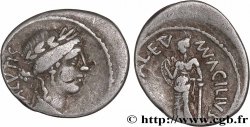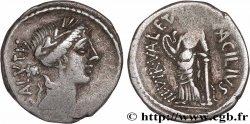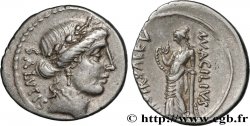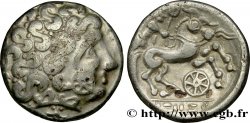v24_0220 - ACILIA Denier
MONNAIES 24 (2005)
Startpreis : 175.00 €
Schätzung : 250.00 €
unverkauftes Los
Startpreis : 175.00 €
Schätzung : 250.00 €
unverkauftes Los
Type : Denier
Datum: 49 AC.
Name der Münzstätte / Stadt : Grèce ou Illyrie, avec Pompée
Metall : Silber
Der Feingehalt beträgt : 950 ‰
Durchmesser : 17,5 mm
Stempelstellung : 4 h.
Gewicht : 4,03 g.
Kommentare zum Erhaltungszustand:
Exemplaire sur un petit flan avec une jolie patine de collection ancienne. Beau portrait. légèrement décentré au revers sur la légende
N° im Nachschlagewerk :
Vorderseite
Titulatur der Vorderseite SALVTIS.
Beschreibung Vorderseite Tête de Salus (la Santé) laurée à droite.
Übersetzung der Vorderseite “Salutis”, (de la Santé).
Rückseite
Titulatur der Rückseite [MN ACIL]IVS/ III VIR VALETV.
Beschreibung Rückseite Valetudo (la Santé) debout à gauche, appuyée sur une colonne de la main gauche et tenant un serpent de la main droite.
Übersetzung der Rückseite “Manius Acilius Triumviri Valetudinis”, (Manius Acilius triumvir monétaire Valetudo).
Kommentare
Pour ce type, M. Crawford a relevé une estimation de 651 coins de droit et de 723 coins de revers ce qui pourrait correspondre à une fabrication totale comprise entre un million et demi et trois millions de deniers. C’est l’un des types monétaires qui permit de financer le parti sénatorial au début de l’année 49 avant J.-C. quand ce dernier rejoignit Pompée qui avait quitté Rome. Les auteurs du Catàlogo ont différencié trois variétés. Sur notre exemplaire, la légende placée derrière la Santé est disposée verticalement.
For this type, Mr. Crawford noted an estimate of 651 obverse dies and 723 reverse dies, which could correspond to a total production of between one and a half and three million denarii. This is one of the monetary types that allowed the financing of the senatorial party at the beginning of 49 BC when the latter joined Pompey who had left Rome. The authors of the Catàlogo differentiated three varieties. On our example, the legend placed behind the Health is arranged vertically
For this type, Mr. Crawford noted an estimate of 651 obverse dies and 723 reverse dies, which could correspond to a total production of between one and a half and three million denarii. This is one of the monetary types that allowed the financing of the senatorial party at the beginning of 49 BC when the latter joined Pompey who had left Rome. The authors of the Catàlogo differentiated three varieties. On our example, the legend placed behind the Health is arranged vertically








 Berichten über einen Fehler
Berichten über einen Fehler Die Seite drucken
Die Seite drucken Teilen meiner Auswahl
Teilen meiner Auswahl Stellen Sie eine Frage
Stellen Sie eine Frage Einlieferung/Verkauf
Einlieferung/Verkauf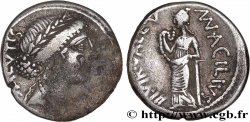
 Details
Details
